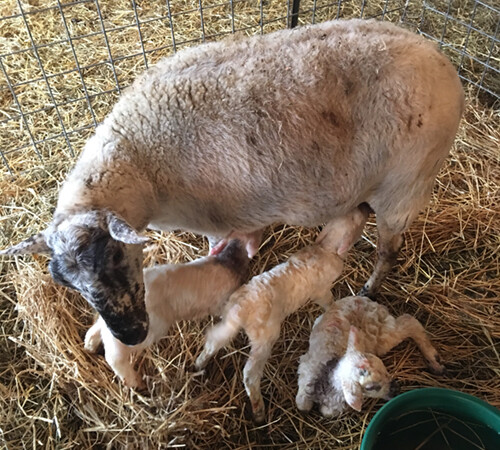

Farmers suffer their greatest sheep losses before weaning, with the majority of lamb deaths occurring during the first 10 days after birth, and more than 20% during the first three days.
Effective lamb management is one of the main contributors to success in sheep production. High lamb mortalities not only result in fewer animals being available for slaughter, but also affect the sustainability of a farm by resulting in fewer replacement animals being available to keep the enterprise going.
Instead of letting nature take its course, management can be made easier if ewes are grouped together and allowed to lamb at around the same time. When deciding on the timing of lambing, the two major considerations are the availability of labour, and the availability of food.
The lambing season should fit into your production schedule. In other words, it should fall outside holidays and the harvesting or planting season, and at a time when there is sufficient grazing or pasture to help ewes regain condition after lambing.
Lambing crates
The lambing environment is another significant influencer of lamb survival. The options are basically under extensive conditions, in smaller camps, or in lambing crates or pens. Lamb mortalities average around 5% in lambing crates in comparison with 10% in small camps and 15% or more under extensive conditions, depending on external threats such as predation.
Lambing crates have a number of other advantages. The small space enhances bonding between ewes and lambs, which in turn prevents lambs from wandering off and dying, and it offers shelter against predators, extreme weather and theft. The system also makes it easy to pair ewes with their lambs for proper record-keeping.
The crates need to be kept dry and clean, as pathogens build up faster in lambing crates than in camps because of the higher concentration of animals. Farmers can address this by limiting the time in crates to five days before and 5 days after lambing.
Alternatively, the ewes can lamb in small camps near the crates and be moved with their offspring to the crates shortly after lambing.
While sunshine is the best disinfectant, the cubicles should be washed and then covered with hydrated lime before straw bedding is added for the next group. The area needs to be well ventilated to prevent respiratory problems, but still provide shelter from the wind and cold.
The umbilical cords of the lambs should be treated with iodine as soon as possible after birth to prevent infection. The ewes and their lambs should be moved from the crates to small groups before being introduced to larger flocks.
The main drawback of lambing crates is their cost, but this is more than justified by the higher lamb survival rate.
To maximise the return on investment, farmers should divide the flock into two or three groups, each with its own lambing period, rather than try to handle the entire flock in one go once a year in a single huge facility. The crates can be used as a ram test station between seasons. Some farmers only use lambing crates for ewes that carry multiples.
Colostrum
Feeding of lambs can be catergorised into three phases, with the first being linked to colostrum. To help them build immunity against pathogens, lambs should receive about 210ml of colostrum per kilogram of bodyweight within the first 24 hours of birth.
Lambs that receive too little colostrum will grow poorly and be weak and more vulnerable to diseases.
Weak lambs can be dosed with 100ml colostrum (saved from ewes that have already lambed) 3-4 times per day for the first 2 days of their lives. Colostrum can last for up to seven days when stored in a fridge and up to six months when frozen.
It should be warmed to room temperature before being given to lambs, and not above 37°C, as this will destroy the antibodies associated with its immunity-building benefits.
To prevent deterioration in quality, colostrum must also be used within an hour after collection or after being warmed. In the absence of colostrum, farmers can buy commercial mixes or mix their own by using 500ml full-cream dairy milk, 120ml cream or three tablespoons of cooking oil, one egg, and one tablespoon of lactose or sugar.
These alternatives do not contain any antibodies, however, and will not offer the same protection against prevalent diseases as colostrum does.
Milk production
Lambs are highly dependent on their mothers’ milk up until weaning, so farmers must ensure that the ewes are in good condition.
Licks or rations containing high levels of bypass protein are especially important during the last six weeks before lambing; this will ensure good-quality colostrum and milk production, maximising the chances of lamb survival.
The type of rations will depend on the type and quality of feed available on the farm, and whether the ewes are carrying multiple lambs or single lambs. Various companies offer commercial premixes to help ewes maintain and regain condition. Milk production of ewes usually peaks four weeks after lambing. Thereafter, lambs will increasingly be given creep feed.
 Contact Jaguza Support
Contact Jaguza Support